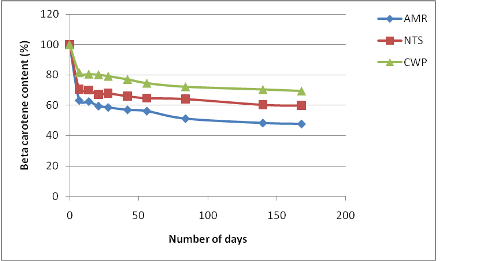
Use of kitchen steel wool as oxygen absorber improves storage retention of beta-carotene in solar-dried vegetables
Abstract
 Vitamin A deficiency remains a major health concern in developing countries whereas the season availability of vegetables could provide for vitamin A. Dehydration is widely used to preserve dark green leafy vegetables (DGLV) but storage in normal atmosphere condition losses beta-carotene by oxidation, therefore requiring use of an oxygen absorber. The study examined use of kitchen steel wool as an oxygen absorber in reducing the loss of beta-carotene content in three indigenous DGLVs that were solar dried and stored for a period of 168 days in four different packing conditions. Fresh vegetables contained between 781.94 to 1047.42 μg/g dry matter (DM) beta-carotene, reducing significantly (p=0.01) to between 653.63 to 712.99 μg/g DM after dehydration. Steel wool oxygen absorber significantly improved (p = 0.02) beta-carotene retention, recording a loss of 19.5 to 37.6% compared to 47 to 72% in normal conditions. Storage of DGLVs under kitchen steel wool oxygen absorber preserves vegetables and retains high levels of beta-carotene.
Full Text:
PDFReferences
E.J. Johnson, Journal of Nutrition in clinical care, 2002, 5, 56-65.
FAO/WHO, International Conference on Nutrition, Geneva, Switzerland, 1992.
E.A. Yetley, American Journal of Clinical Nutrition, 2007, 85,269S-276S.
C.A. Mulholland, D.J. Benford, American Journal of Clinical Nutrition, 2007, 85, (1), 318S-322S.
G. Codija, Sight and Life Newsletter, 2001, 4, 18.
R.M. Munene, H.S. Adala, F.S. Rana, East African Medical Journal, 2003, 80, 476-479.
S. Veda, A. Kamath, K.Platel, K.K. Begum, Srinivasan, Molecular Nutrition and Food Research, 2006, 50, 1047-52.
O. M. Funke, Food and Nutrition Sciences, 2011, 2, 249-252S.J. Schwartz, J. Food Sc. and Tech. 2001, 25, 1.
H. Nyambaka, J. Ryley, Journal of Food Chemistry, 1996, 55, 63-72.
Y.H. Hui, Encyclopedia of Food Science and Technology, Vol. 1, John Wiley and Sons Inc., New York, pp 293-308, 1992.
C. Emenhiser, R.H. Watkins, N. Bulux, J. Barrows, S.J. Schwartz, Journal of Food Quality, 1999, 22, 63-73.
T.A Kennedy, D.C. Liebler, Chemical Research in Toxicology, 1991, 4, 290-295.
L. Vermeiren, F. Devlieghere, M. van Beest, N. de Kruijf, J. Debevere, Trends in Food Science & Technology, 1999, 10, 77-86.
P. Appendini, J.H. Hotchkiss, Innovative Food Science & Emerging Technologies. 2002, 3, 113-126.
S. Mangaraj, T.K. Goswami, P.V. Mahajan, Food Engineering Reviews, 2009, 1, 133-158.
A. Yoshiuki, Oxygen absorbers: Is it the answer to shelf life problems? Special Feature in Shelf Life Technology, Asia Pacific Food Industry, 1991.
J. López-Cervantes, D.I. Sánchez-Machado, S. Pastorelli, R. Rijk, P. Paseiro-Losada, Food Additive Contaminants Journal, 2003, 20, 291-9.
X.A. Ramoneda, P.A. Ponce-Cevallos, M.del P. Buera, B.E. Elizalde, J. Sci Food Agric, 2011, 91, 2587-93
R. Marcrae, R.K Robinson, M.J. Sadler, Encyclopedia of Food Science Technology and Nutrition, Vol. 1, Academic Press, USA, 1993.
T.C. Mosha, R.D. Pace, S. Adeyeye, H.S. Laswai, K. Mtebe, Plant Foods for Human Nutrition, 1997, 50 (3): 189-201.
D. Dutta, A. Dutta., U. Raychaudhuri. R. Chakraborty, J. Food Eng. 76, 2006: 538–546.
L.K. Henry, G.L. Catignani, and S.J. Schwartz, JAOCS, 1998, 75, 823-829.
A.Bechoff, C. Dhuique-Mayer, M. Dormier, K.I. Tomlins, R. Brulanger, D. Dufour, A. Westby, Food Chemistry, 2010, 121, 348-357.
E. Larsen, L.P. Christensen, J Agric and Food Chem, 2005, 53, 6598-6602.
DOI: http://dx.doi.org/10.13171/mjc.1.6.2012.26.07.21
Refbacks
- There are currently no refbacks.
Copyright (c) 2015 Mediterranean Journal of Chemistry
